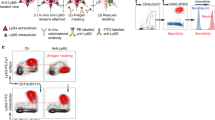Abstract
NEUTROPHIL-mediated inflammation is involved in a number of human clinical manifestations, including the adult respiratory distress syndrome, multi-organ failure and reperfusion injury1. One way of inhibiting this type of inflammatory response would be to block competitively the adhesive interactions between neutrophils and the endothelium adjacent to the inflamed region2. The lectin-containing3,4murine adhesion molecule gp90MEL, the homing receptor, is found on all leukocytic cells, including neutrophils5. MEL14, a monoclonal antibody directed against this adhesion molecule, blocks lymphocyte traffic to lymph nodes6 and extravasation of neutrophils from blood to inflammatory sites7. Here we show that administration to mice of a soluble immunoglobulin chimaera containing the murine homing receptor extracellular domain significantly decreases the number of neutrophils that migrate to the peritoneum in response to the inflammatory irritant thioglycollate. These results indicate that soluble forms of a single type of adhesion molecule, the homing receptor, could be clinically effective compounds for the inhibition of neutrophil-mediated inflammation.
Similar content being viewed by others
References
Gallin, J., Goldstein, I. & Snyderman, R. Inflammation: Basic Principles and Clinical Correlates (eds) (Raven, New York, 1988).
Springer, T. Nature 436, 425–434 (1990).
Lasky, L. et al. Cell 56, 1045–1055 (1989).
Siegelman, M., Van de Rijn, M. & Weissman, I. Science 243, 1165–1172 (1989).
Gallatin, M. et al. Cell 44, 673–680 (1986).
Mountz, J., Gause, W., Finkelman, F. & Steinberg, A. J. Immun. 140, 2943–2949 (1988).
Lewinsohn, D., Bargatze, R. & Butcher, E. J. Immun. 138, 4313–4321 (1987).
Watson, S. et al. J. Cell Biol. 110, 2221–2229 (1990).
Capon, D. et al. Nature 337, 525–531 (1989).
Imai, Y., Singer, M., Femie, C., Lasky, L. & Rosen, S. J. Cell Biol. (submitted).
Lasky, L. et al. Science 233, 209–212 (1986).
Bowen, B., Fennie, C. & Lasky, L. J. Cell Biol. 110, 421–427 (1990).
Gallatin, M., Weissman, I. & Butcher, E. Nature 304, 30–34 (1983).
Streeter, P., Rouse, B. & Butcher, E. J. Cell Biol. 107, 1853–1862 (1988).
Jutilla, M., Rott, L., Berg, E. & Butcher, E. J. Immun. 143, 3318–3324 (1989).
Marlin, S. et al. nature 344, 70–72 (1990).
Fanslow, W. et al. Science 248, 739–742 (1990).
Fischer, A. et al. Lancet ii, 1058–1061 (1986).
Arfors, K. et al. Blood 69, 338–340 (1987).
Cosimi, A. et al. J. Immun. 144, 4604–4612 (1990).
Bevilacqua, M. et al. Science 243, 1160–1165 (1989).
Johnston, G., Cook, R. & McEver, R. Cell 56, 1033–1044 (1989).
Larsen, E. et al. Cell 59, 305–312 (1989).
Author information
Authors and Affiliations
Rights and permissions
About this article
Cite this article
Watson, S., Fennie, C. & Lasky, L. Neutrophil influx into an inflammatory site inhibited by a soluble homing receptor–IgG chimaera. Nature 349, 164–167 (1991). https://doi.org/10.1038/349164a0
Received:
Accepted:
Issue Date:
DOI: https://doi.org/10.1038/349164a0
- Springer Nature Limited
This article is cited by
-
Pan-selectin antagonism improves psoriasis manifestation in mice and man
Archives of Dermatological Research (2006)
-
Dominant role of L‐ and P‐selectin in mediating CXC chemokine‐induced neutrophil migration in vivo
British Journal of Pharmacology (2001)
-
Role of selectins on IgE‐mediated skin reaction
British Journal of Pharmacology (2000)





